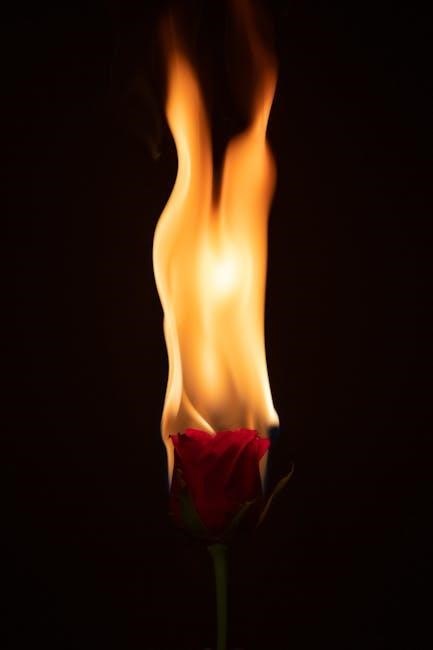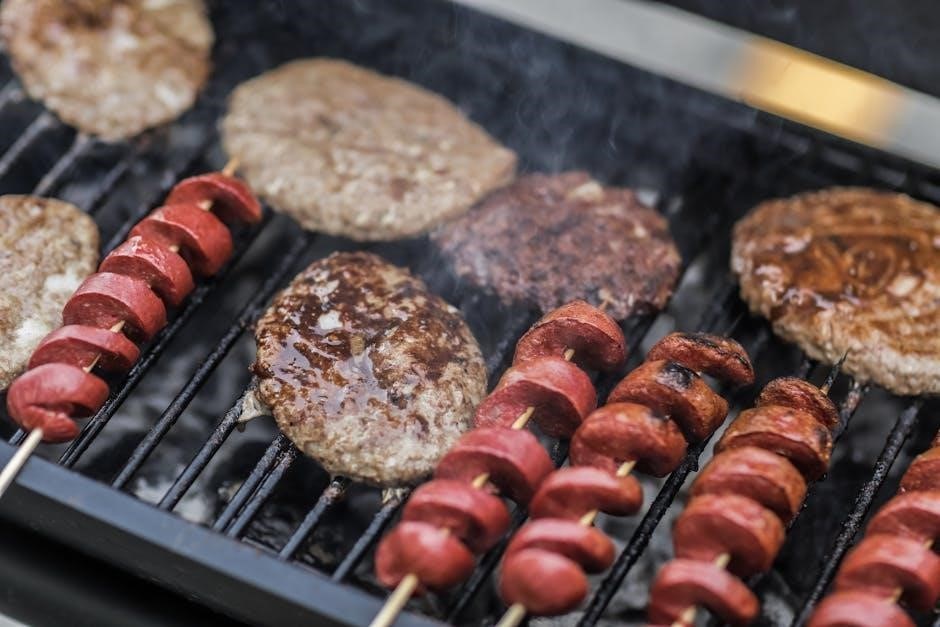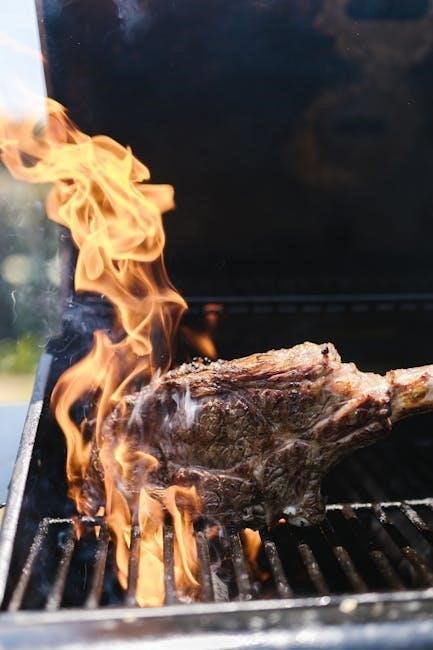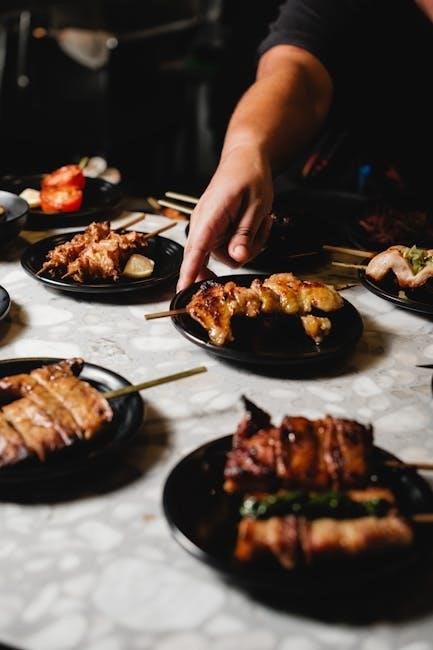
Safety Precautions for Char-Broil Grill Usage
Always use LP gas with the provided regulator‚ follow local or National Fuel Gas Code‚ handle LP gas per ANSI/NFPA 58‚ wear gloves‚ and never use water on grease fires for safety.
1.1 Handling LP Gas and Regulator/Valve Assembly
Use only LP (propane) gas with the regulator/valve assembly provided. Ensure grill installation complies with local codes or the National Fuel Gas Code (ANSI Z223.1/NFPA 54). Handle LP gas in accordance with the LP Gas Code (ANSI/NFPA 58). Store and transport LP gas cylinders upright in a well-ventilated area‚ away from open flames or sparks. Always turn off the gas supply valve when the grill is not in use. Inspect the regulator and hoses for damage or leaks before each use. Never attempt to modify or repair the regulator/valve assembly yourself. If issues arise‚ contact a qualified technician. Keep the grill and LP gas cylinder outdoors in a well-ventilated area‚ out of reach of children. Follow all safety guidelines to prevent accidents and ensure safe grilling experiences.
1.2 Electrical Component Safety Measures
Ensure all electrical components of your Char-Broil grill are handled with care. Keep the grill and electrical parts away from water to avoid shocks or damage. Never use extension cords or adapters that could overload circuits. Always follow the manufacturer’s instructions for any electrical accessories. Regularly inspect cords and plugs for damage; replace them if worn. Avoid touching electrical components with wet hands. If your grill has an electric ignition‚ ensure it is properly installed and maintained. Never attempt to modify or repair electrical parts yourself. For any issues‚ contact a licensed electrician. Keep children away from electrical components to prevent accidents. Store the grill in a dry place when not in use to protect electrical systems. Adhering to these precautions ensures safe and reliable operation of your Char-Broil grill’s electrical features.
1.3 Preventing and Managing Grease Fires
Preventing grease fires is crucial for safe Char-Broil grill usage. Regularly clean the grill‚ especially the burners and drip pans‚ to remove grease buildup. Trim excess fat from meats before grilling to minimize drips. Never use water to extinguish a grease fire‚ as it can spread the flames. Instead‚ turn off the burners and close the lid to starve the fire of oxygen. Keep a fire extinguisher rated for grease fires nearby. For minor flare-ups‚ adjust the heat or move food to a cooler part of the grill. Always preheat the grill properly to avoid excessive smoke and grease accumulation. Ensure the grill is well-ventilated to prevent vapors from igniting. Store the grill in a dry‚ well-ventilated area when not in use. By following these steps‚ you can significantly reduce the risk of grease fires and ensure a safer grilling experience.

Assembly Instructions for Char-Broil Grills
Use the CharBroil BBQ Guide app for digital assembly instructions. Spread parts on a soft surface‚ read all directions‚ and wear gloves to avoid sharp edges during assembly.
2.1 Tools and Parts Required for Assembly
Ensure you have all necessary tools and parts before starting. Common tools include screwdrivers‚ wrenches‚ and Allen keys. A soft blanket or cloth is recommended for laying out parts to prevent damage. Protective gloves are advisable due to potential sharp edges. Organize all components‚ including hardware and instruction manuals‚ to avoid misplacement. Verify the completeness of your parts list using the provided manual or digital guide. Adhesive or sealants may be needed for certain connections. Double-check the app or website for specific requirements. Always refer to the CharBroil BBQ Guide app or official manual for detailed lists of tools and parts tailored to your model. Proper preparation ensures a smooth assembly process and minimizes delays.
2.2 Step-by-Step Assembly Process
Begin by unpacking and organizing all parts on a soft surface to prevent damage. Assemble the base and frame using the provided hardware‚ ensuring stability. Attach wheels and handles securely. Next‚ install the burners and heat deflectors‚ aligning them properly. Connect the gas regulator to the propane tank tightly. Attach the cooking grates and assemble the lid‚ ensuring it aligns with the hinges. Follow the manual for specific bolt and screw placements. Double-check all connections‚ especially gas lines‚ for leaks. Use soapy water to test for leaks if necessary. Once assembled‚ refer to the ignition instructions to test the burners. Always follow the CharBroil BBQ Guide app or official manual for precise steps tailored to your grill model. Proper assembly ensures safe and efficient grilling.
2.3 Common Mistakes to Avoid During Assembly
Avoiding common mistakes during assembly ensures your Char-Broil grill functions safely and efficiently. One frequent error is not reading the manual thoroughly‚ leading to misplaced parts or incorrect bolt usage. Always verify each part matches the diagram before securing it. Another mistake is overtightening bolts‚ which can damage threads or strip screws. Tighten all connections firmly but avoid excess force. Improper alignment of the cooking grates or burners can cause uneven heating‚ so ensure they fit snugly; Additionally‚ neglecting to test gas connections for leaks is dangerous. Use soapy water to check for bubbles‚ indicating a leak. Lastly‚ skipping the final inspection is risky—double-check all connections‚ burner functionality‚ and lid alignment. By avoiding these pitfalls‚ you ensure a safe and successful assembly process for your Char-Broil grill. Proper assembly is crucial for optimal performance and longevity of your grill.

Operating and Maintenance Tips
Regularly clean grates‚ burners‚ and grease pans. Preheat grills properly‚ store in dry areas‚ and ensure proper ventilation. Follow Char-Broil guidelines for safe and optimal performance‚ enhancing durability and flavor.

3.1 Preheating and Temperature Control
Preheating your Char-Broil grill is essential for achieving even cooking and preventing food from sticking. Turn all burners to high‚ close the lid‚ and let the grill heat up for 10-15 minutes; This ensures the grates reach the optimal temperature for searing. Use the stepless temperature regulator to adjust heat levels precisely‚ maintaining consistent cooking conditions. Always preheat with the lid closed to allow internal temperatures to stabilize. For different foods‚ adjust the heat as needed—high for searing steaks‚ medium for burgers‚ and low for delicate fish or vegetables. Regularly monitor the temperature gauge to avoid overheating‚ which can damage the grill or burn food. Proper preheating and temperature control are key to achieving professional grilling results and extending the life of your Char-Broil grill.
3.2 Cleaning and Storage Recommendations
Regular cleaning is crucial for maintaining your Char-Broil grill’s performance and longevity. After each use‚ brush the grates with a wire brush to remove food residue and wipe them with oil to prevent rust. Empty the grease tray and clean it with soap and water to avoid flare-ups. For deeper cleaning‚ remove and wash the burner assembly and heat deflectors. Store the grill in a dry‚ well-ventilated area‚ preferably covered with a Char-Broil grill cover to protect it from the elements. If the grill is equipped with an LP tank‚ ensure it is turned off and stored upright in a secure‚ outdoor location. Proper cleaning and storage prevent rust‚ pests‚ and damage‚ ensuring your grill remains in excellent condition for future use.
3.4 Best Practices for Grilling Different Foods
When grilling various foods‚ adjust techniques for optimal results. For meats‚ trim excess fat to prevent flare-ups and ensure even cooking. Place burgers and steaks on the grill away from direct flames to avoid charring. For vegetables‚ brush with oil and season lightly before grilling over medium-high heat for crisp texture. Fish requires delicate handling—use a fish basket to prevent sticking and flip gently. For poultry‚ preheat the grill to a consistent temperature and cook with the lid closed to ensure even cooking. Always use a food thermometer to verify internal temperatures for safety. Rotate foods halfway through cooking for uniform searing. Avoid pressing down on burgers to retain juices. For delicate items like vegetables or shrimp‚ use skewers to simplify flipping. Regularly clean the grates to prevent sticking and food residue transfer. Proper food handling ensures a safe and delicious grilling experience.
